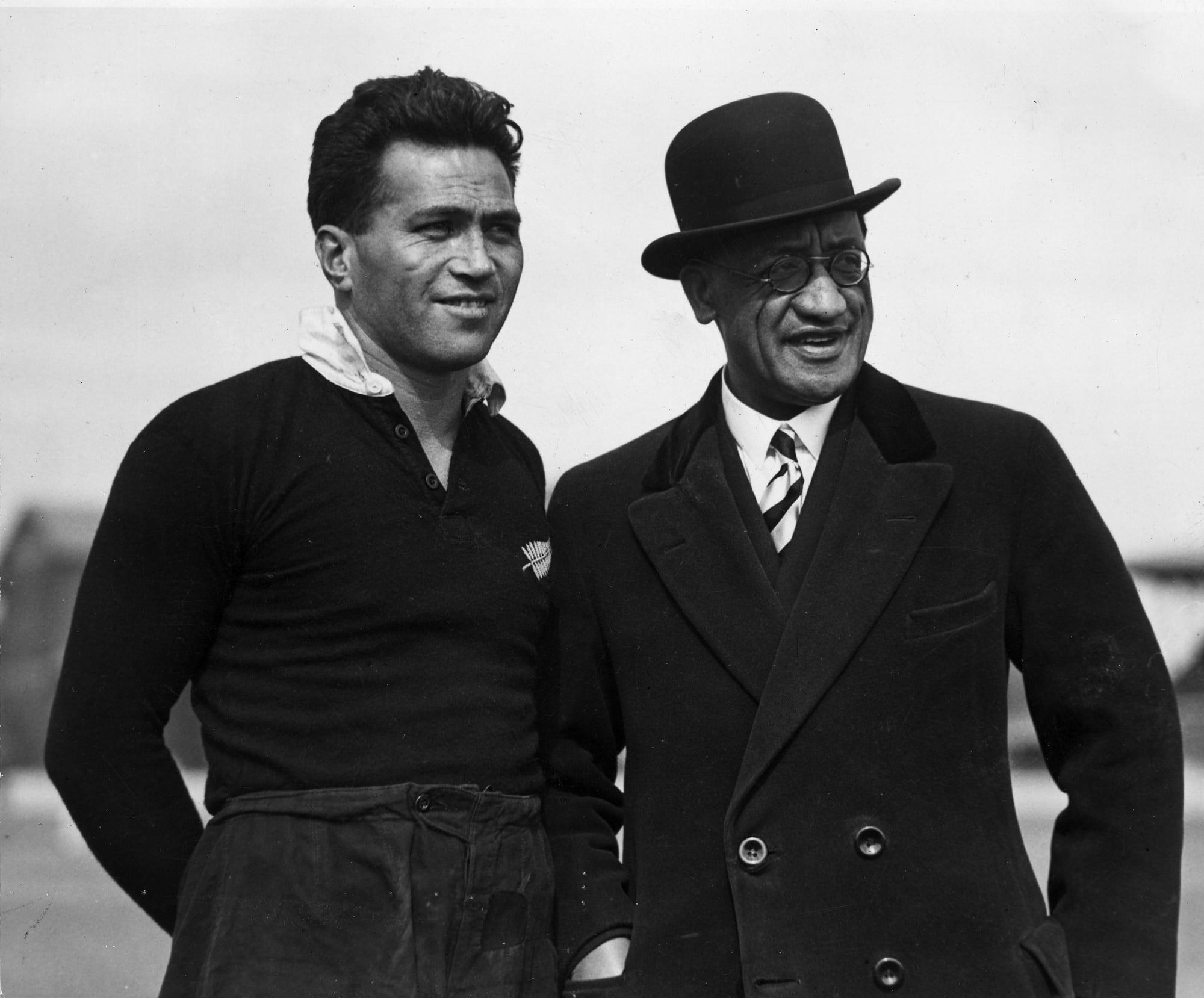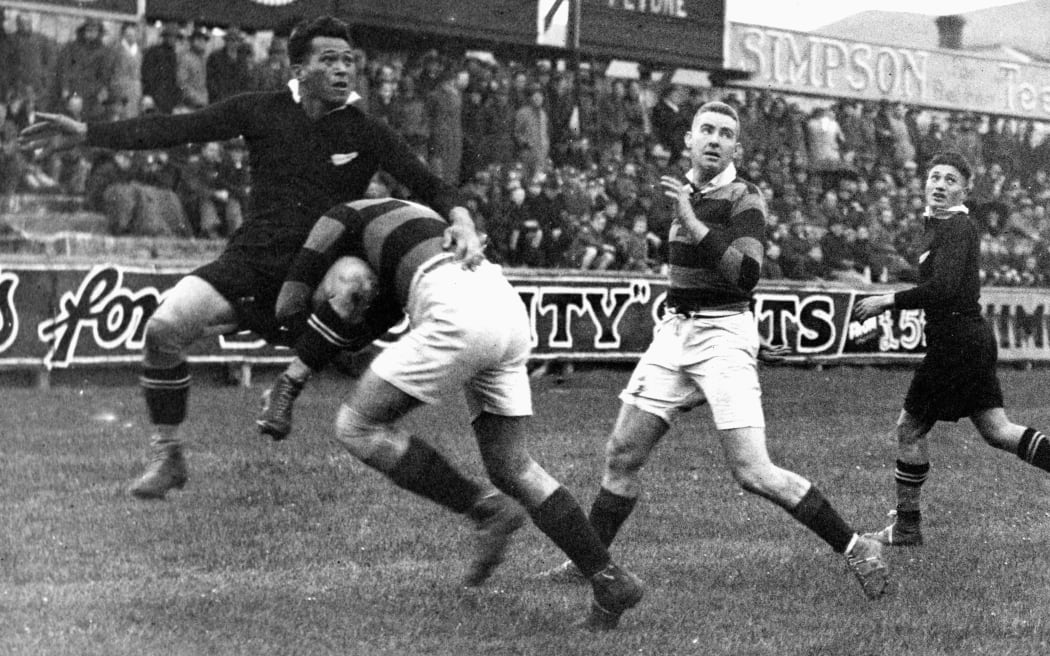George Nepia left New Zealand as a fullback for the All Black tour of 1924–25, and returned a star of the Invincibles All Black team
During the tour of Britain, France and Canada none entertained more famously than Nepia, who played ‘virtually faultless rugby’. He went on to become a veteran of fourteen tests, and a player who never once played for a losing All Black team.
Nepia’s success on the field had much to do with his personal skills and athleticism, but also something to do with the history of Māori rugby.
It is generally accepted that the ‘birth’ of New Zealand rugby occurred in Nelson on 14 May 1870, and rugby, like most sports introduced into the Māori world in the nineteenth century, was quickly incorporated into the rhythm of Māori community life.
Rugby became a new focus around which people could engage across tribal boundaries, as well as across the cultural boundaries of national and international sporting competition.
In the 1880s intertribal and region-based competitions were established; Te Aute College and the Māori Agricultural College in Hastings became the early nurseries of Māori rugby, grooming some of New Zealand’s finest players.
Among them was Tom Ellison, who played in the New Zealand Native Representatives team in 1888. Ellison, along with fellow Te Aute player Hoeroa Tiopera, and two other members of the Native team, Tabby Wynyard and Davy Gage, also went on to be selected for the first New Zealand squad of 1893.
From these nineteenth-century beginnings, Māori players defined two of the most enduring features of New Zealand rugby: it was during the 1888 Native tour that the haka was first performed in front of 50,000 people, and it was at the inaugural meeting of the New Zealand Rugby Football Union in 1893 that Ellison proposed a national uniform that included the ‘black jersey with a silver fern’.

George Nepia had a career in both rugby and league. He captained the New Zealand Maori team that toured Australia in 1935. Here he is photographed with team manager Kingi Tahiwi, probably at the Sydney Cricket Ground shortly before the game against New South Wales. Photo: Alexander Turnbull Library, 1/2-C-22477-F
A few decades later, Nepia followed in the footsteps of those pioneering Māori players, honing his rugby skills at the Maori Agricultural College in the early 1920s. There he was mentored by the American, Erwin Moser.
Nepia ‘was taught to kick with skill and precision and instructed in the spiral kick, and the formative seeds of his tackling skills were implanted’. In 1921, he was selected for East Coast Districts, and in 1922 was in the ‘legendary Hawke's Bay team’.
Nepia’s big break came in 1924. The Te Mori Rose Bowl match between northern and southern Māori was regarded as a trial for the 1924–25 All Black team to tour the British Isles.
Nepia played at fullback, a new position in which his cousin advised him to ‘catch the ball on the full, tackle soundly, and put the ball out securely when kicking for touch’.
After three trials Nepia was selected for the tour. The team won all its 32 games. Nepia, who scored 77 points, was ‘noted for his fierce tackling, catching of the ball, kicking and ability to stop opposition forward rushes’.
Nepia’s success on the rugby field was phenomenal and in total he ‘played 46 matches for the All Blacks, scoring a total of 99 points’. However, it was not without some controversy.
Following Nepia’s successful British Isles tour, he was not selected for the 1926–27 Māori team’s international tour, and in 1928 he was ‘omitted from the 1928 tour of South Africa because of his race’.
In 1935, Nepia switched codes to league, mainly due to the financial rewards during the Depression years. He returned to rugby in 1947 when ‘an amnesty allowed league players to be readmitted to rugby union, and Nepia played two games for East Coast’.
Thereafter, Nepia ‘took up refereeing’ and began work as a farm manager in the Wairoa area.
His retirement from play was acknowledged in 1982 when he received a rapturous reception from thousands at St Helens ground in Swansea, Wales.
Furthermore, in 1986 ‘he was elected by the South African Rugby Board as life vice president, and in the same year was the subject of television's This is your Life.’ That same year, Nepia died at Ruatōria on 27 August.
*This story reproduces and/or draws on text and themes in Atholl Anderson, Judith Binney, Aroha Harris, Tangata Whenua: An Illustrated History, Bridget Williams Books, 2014. Additional sources: Malcolm Mulholland, Beneath the Māori Moon: An Illustrated History of Māori Rugby, Huia, Wellington, 2009; Robin C. McConnell, 'Nepia, George', from the Dictionary of New Zealand Biography, Te Ara – the Encyclopedia of New Zealand.


